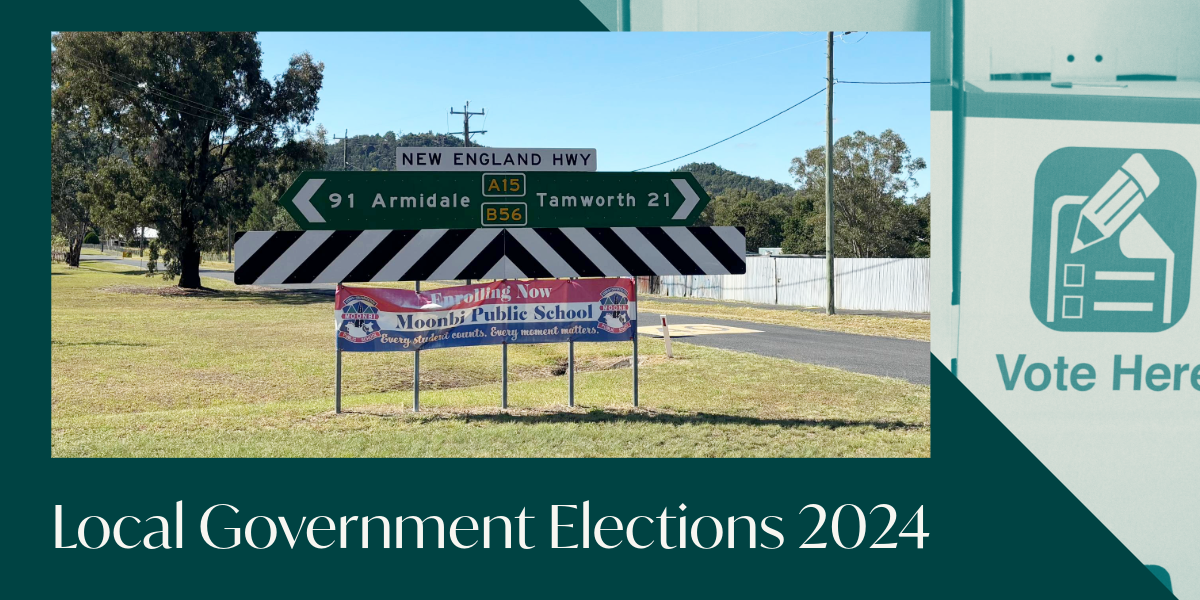Villages in New England could be a key battleground in the upcoming council elections, with outlying towns feeling marginalised by the larger towns that form the centres of their local government areas, with some candidates seeking to take advantage of the resentment brewing in outlying villages.
The tyranny of distance means that many small villages do not enjoy the same level of services, and can feel left out and overcharged and underloved by their council.
Feel like an afterthought
Greens candidate Ryan Brooke has been campaigning in Manilla, and will head out to Barraba, an hour outside Tamworth, this weekend.
“The big thing that you hear consistently is that Tamworth Councils are too focused on Tamworth,” Brooke said, “and that other towns in the region sort of become an afterthought.”
“I think it’s a fair complaint, especially with the Special Rate Variation, and a lot of that infrastructure it’s going towards is all Tamworth-based.”
Some of the issues Brooke says Manila residents are worried about are straightforward, like green waste collection, and consistent opening hours for local pools, services Tamworth residents have access to.
Brookes has stated that while projects like the aquatics centre and the skywalk would be nice projects to have, he does not think it’s appropriate to request a Special Rate Variation to pay for them during the current cost-of-living crisis.
Specifics wanted on their pain points
Labor Candidate Thom Robinson is a Kootingal resident and notes that while he’ll act in concert with his fellow labor candidates, if elected, he is keen to draw attention to the issues in his village.
“I’m focused on Kootingal, that’s where I live,” Robinson says.
“There’s 2000 people and obviously, that’s a very small section of the LGA, but it’s still an important section.”
Robinson is pushing three main, specific issues for Kootingal: after-hours bulk-billed medical care, more ranger patrols to deal with stray animals, and better street lighting.
“It’s not a ward,” Robinson says, “but sometimes you have to treat it like a ward, but something I think that in these key areas that have big populations and satellite towns you have to treat them like a ward.”
“My focus on council would be Kootingal and the other satellite towns.
There’s a lot of issues that are common to all the satellite towns that simply aren’t noticed in Tamworth, Robinson says, and that’s what he is focusing on.
“As far as Tamworth city is concerned I think it’s pretty well-represented by the current council.”
“And when I say ‘pretty well’, I mean it’s been the focus of the current council and the satellite towns have been left out of consideration of all major issues.”
Robinson notes the differences between campaigning in the villages compared to Tamworth, noticing that candidates can speak “in very generic terms” about issues in Tamworth, as there’s a wide variety of known issues in Tamworth.
“They’re just speaking broadly about needing a strong and positive voice for the community.
“Whereas when you go into the satellites, they want to know specifically, what are the issues that you see in our community, and how do you think that you as a councillor are able to resolve them?”
Is Tamworth Regional Council’s area too big?
Professor Joseph Drew is a resident of Moonbi, and also happens to be the Southern Hemisphere’s leading academic on local government finance.
“I believe the councillors are doing their best to represent all the communities in Tamworth,” Drew said, but also stated that problems that don’t directly affect councillors often aren’t given priority.
“Tamworth is a very large area, and let’s face it, if you’re not living in a village, you’re not seeing things.”
Drew cites basic maintenance concerns in Moonbi, like noise pollution and damaged roads, that are often ignored by Tamworth, and have to be specifically drawn to the council’s attention via letters.
“I guess the best case scenario, you’d have councillors from every village.”
“If councillors were living here, they’d probably notice these things.
“They’d probably bring the issues to the council table, and they’d be discussing them, and it would be dealt with in a democratic fashion.”
Drew says that one of the key problems is that the Tamworth LGA is too large, and that having large LGAs centred around a single big population centre where most of the votes are means that places outside that centre will be marginalised, as the councillors simply aren’t as aware of issues outside their base – and that those issues are more expensive to fix.
“I was doing some work with a Portuguese colleague, and his quote to me was, ‘Are you absolutely insane in Australia? Who makes a local government area bigger than a country and expects it to be able to survive?’”
While not entirely against council amalgamations, saying that some are good ideas, and even some that didn’t go ahead were still good ideas, Drew believes that Tamworth is too big. He argues Tamworth LGA is “an extreme outlier” in terms of land area, not just in Australia but in the entire OECD, and that the amalgamation that formed Tamworth Regional Council resulted in an LGA that is inefficient to run.
Simply fixing something in Moonbi is more expensive than Tamworth, Drew says, simply because of travel times, which are an unavoidable cost in a large LGA that doesn’t have the population base to pay for it.
“Time and time again, the scholarly work has shown that the major determinant of cost and hence inefficiency is distance,” Drew says.
Advertising with New England Times is a cost effective and reliable way to reach New England locals who are interested and engaged. Find out more here.


